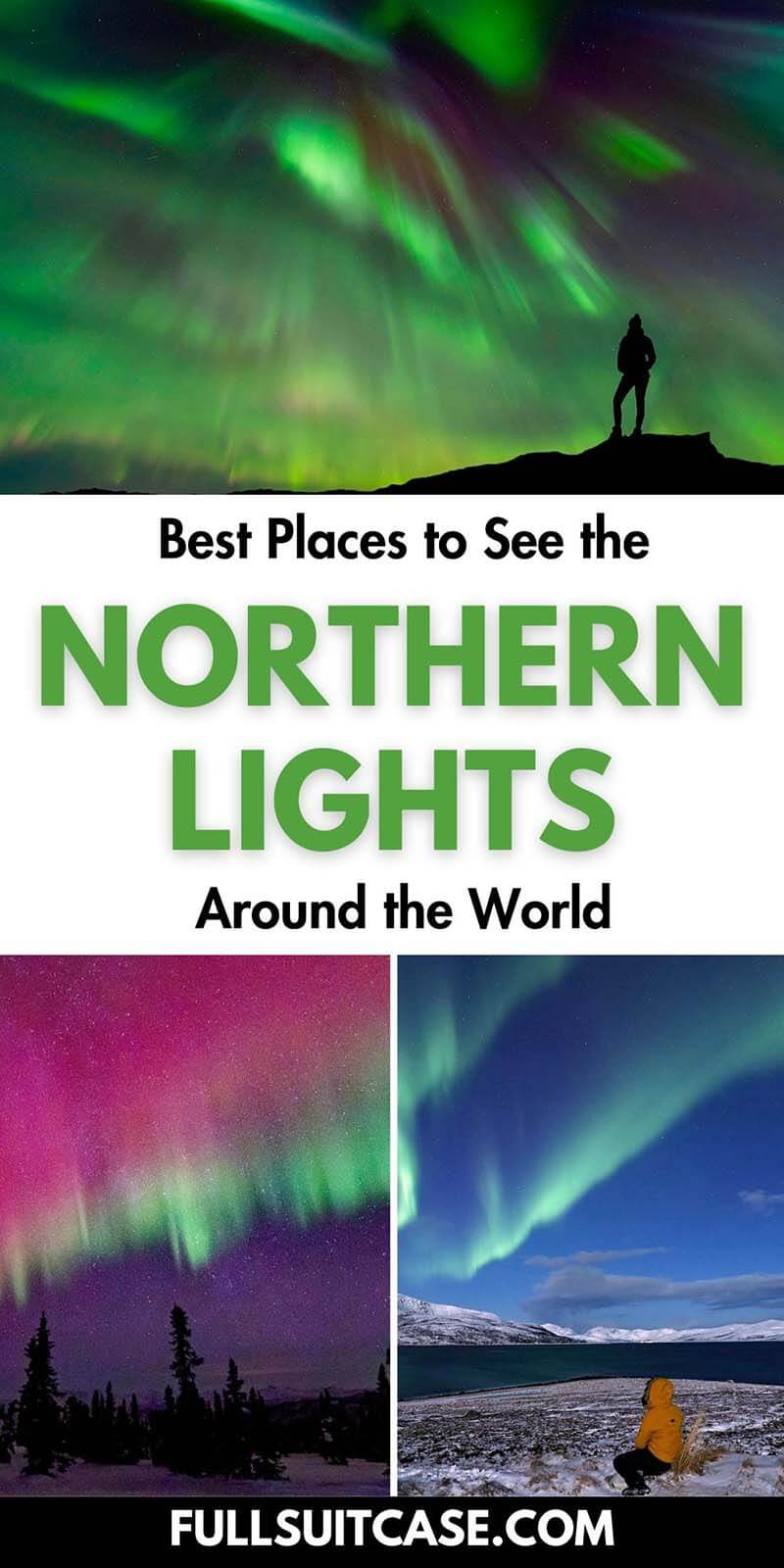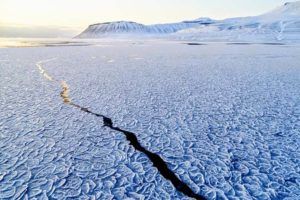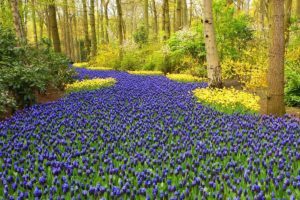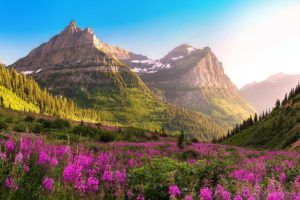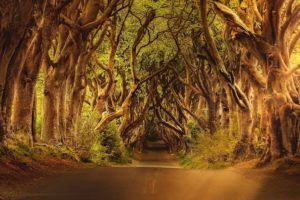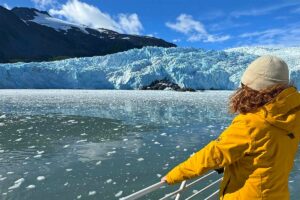5 Best Places to See the Northern Lights in the World
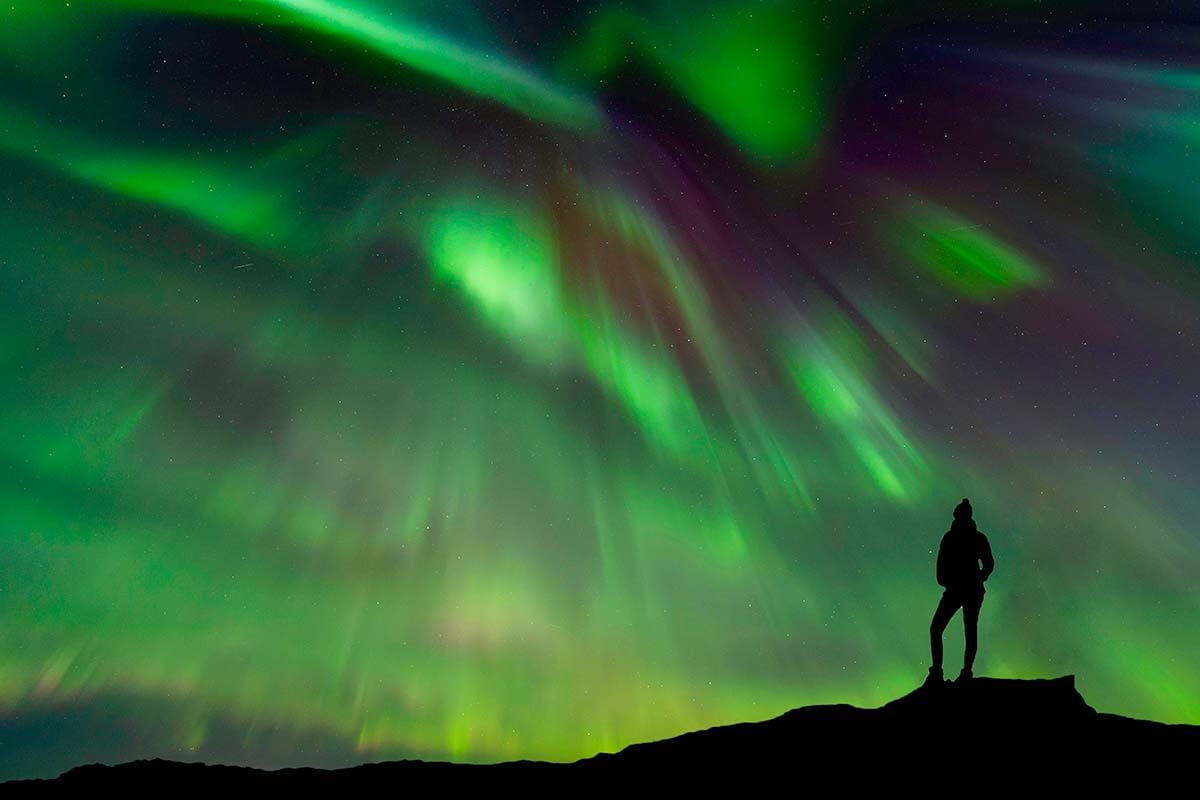
This site contains affiliate links, which means that we may earn a small commission, at no cost to you, for qualifying purchases. It supports the work that goes into keeping this content free. Thanks for reading! More info: Privacy Policy.
Dreaming of seeing the Northern Lights and wondering where to travel to increase your chances? In this guide, we cover the best places to see the northern lights in the world, with practical information to help you choose the right destination for your bucket-list trip.
The northern lights are one of those natural wonders that most people dream of seeing at least once. While auroras can appear anywhere in the high latitudes, there are a few destinations where your chances are much higher, thanks to a prime location on the aurora circle, good infrastructure, and easy access to amazing scenery that makes the experience even more rewarding.
In this article, we showcase the very best places to see the aurora borealis, from northern Norway and Finnish Lapland to Alaska, and beyond. Each destination has its own strengths, whether it’s easy logistics, reliable aurora sightings, or a wide array of other bucket list activities.
Good to know: This guide is based on personal experience. I’ve visited all of these destinations, seen the northern lights many times, and loved each place for different reasons. While it’s hard to pick a single “best,” I’ve ranked them from 1 to 5 based on how likely you are to see auroras during a short trip. This way, you can choose the destination that best fits your travel style and priorities.
TIP: Before you start planning a trip, there are a few things you may want to know – from the best season to aurora forecast apps, and more – check out our practical tips below.
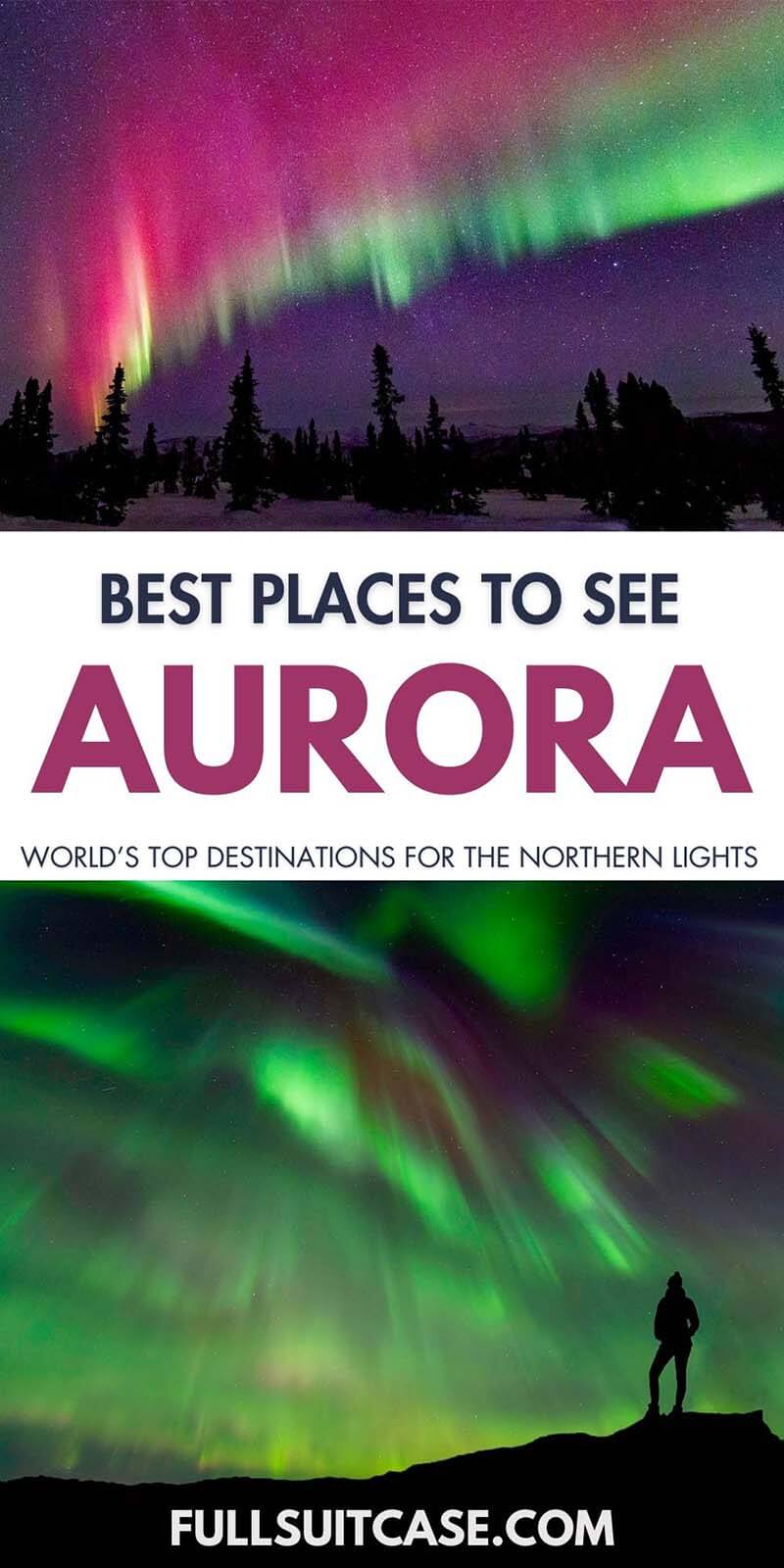
Practical Tips for Planning a Trip to See the Northern Lights
- Travel in the right season. Depending on the destination, the northern lights season runs roughly from late August to mid-April. The best months are mid-September through late March, when the nights are longest and darkest. The equinoxes (around 20 March and 23 September) are often considered peak times, but don’t get too fixated on specific dates – you can see incredible aurora displays anytime during the season.
- Stay at least three nights (the more, the better). This is the single best way to improve your chances. Even in prime locations, you won’t see auroras every night, so giving yourself several nights greatly increases your odds.
- Plan other activities. The northern lights are never guaranteed. To avoid disappointment, fill your days with activities like dog sledding, snowmobiling, fjord cruises, hiking, or local cultural experiences, so your trip is memorable either way. Early autumn is milder and perfect if you want to combine aurora hunting with hiking and sightseeing. If you are interested in snow-based activities, plan a trip between late November and mid-March. Keep in mind that December and January are the darkest months, and sightseeing can be very limited, especially in the northernmost regions.
- Don’t obsess over the forecast. Weather and aurora predictions can change at the last minute. Instead of stressing about the KP index or long-term predictions, focus on being in the right place at the right time of year and making the effort to go out each night. On our most recent trip to Lapland, the night with the worst forecast ended up delivering the best aurora show.
- Install the right apps. A few reliable apps can make a big difference when chasing auroras. My Aurora Forecast and Aurora Alerts are useful for tracking solar activity, while Windy or Yr.no are excellent for checking cloud cover. Many destinations also have their own local apps, sometimes with real-time, location-specific alerts, so it’s worth doing a bit of research or asking your accommodation for recommendations. Just keep in mind that these tools are best for short-term planning and checking conditions on the night itself – not for predicting weeks in advance.
- Make an effort and be prepared to move. While you might get lucky and see auroras from your hotel room, your chances are much higher if you go out to darker spots or chase clearer skies. Cloud cover and light pollution are the biggest obstacles, so you have to be flexible and willing to travel around if necessary. This is where guided aurora tours can make a big difference.
- Don’t worry about the full moon. While moonlight can make it a bit more difficult to see weak auroras, it doesn’t ruin aurora displays completely. It can even make the landscapes around you more visible, which often looks beautiful in photos. One of the best northern lights displays I’ve ever seen was during a full moon.
- Dress and pack smart. Nights can be extremely cold, especially if you’re standing still outside for hours. Bring gloves, a hat, warm shoes, wool socks, and a windproof outer layer. Hand and foot warmers make a big difference! I also always pack a thermos with hot tea and some snacks – in case the night turns out to be really long and cold.
- Bring a tripod (and patience). If you want good photos, a tripod is essential, and learn the basics of manual settings beforehand. Just as important: be patient. Some of the best aurora shows happen well after midnight, when many people have already gone back inside.
READ ALSO: How to Photograph the Northern Lights
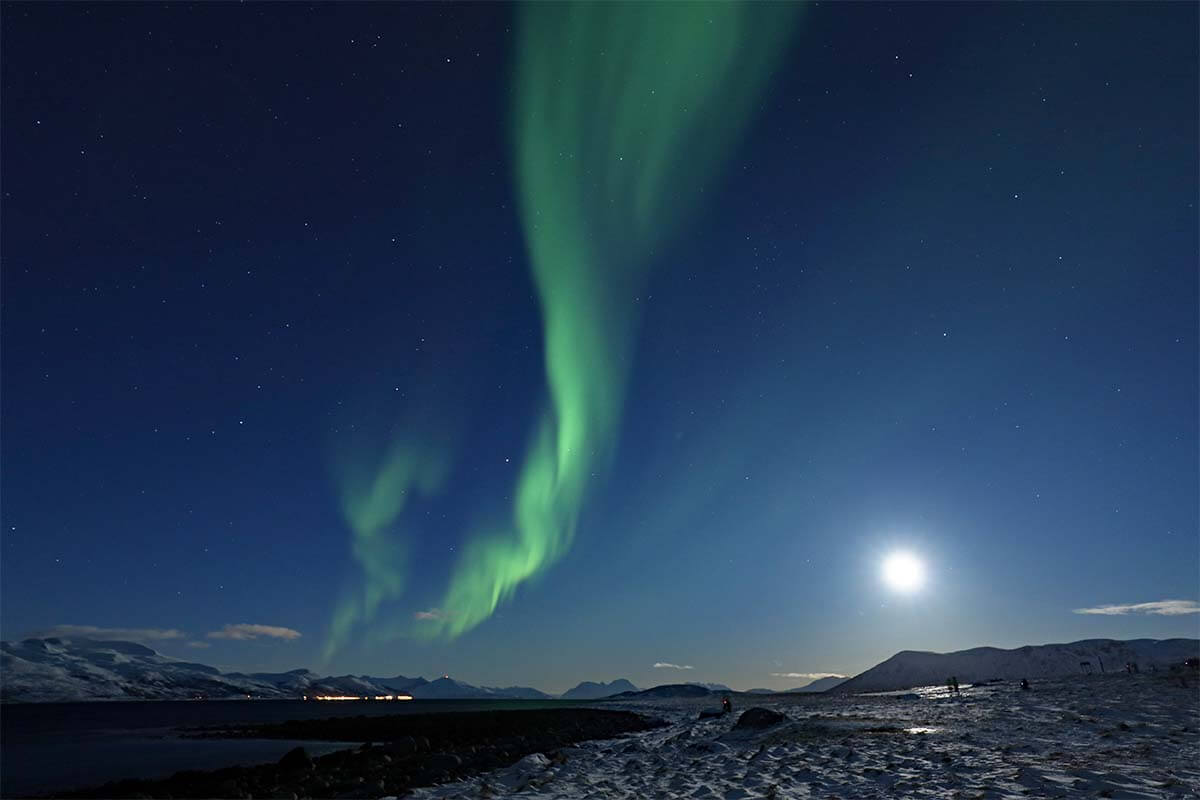
Here are the best places on Earth to watch the northern lights:
1. Tromsø, Northern Norway
Best for: High aurora chances, Arctic scenery, and bucket-list activities.
Northern Norway is one of the best regions in the world to see the northern lights, with frequent sightings across the Arctic. If you’re looking for a specific town to base yourself in, Tromsø – also known as the “Gateway to the Arctic” – is hard to beat.
Sitting directly under the auroral oval, Tromsø has the most frequent northern lights displays in the world. On clear, dark nights, auroras can appear almost every evening, even during periods of low solar activity (as low as KP 1–2).
Furthermore, its coastal setting, combined with well-connected roads in every direction, makes it easy to chase clear skies when the weather doesn’t cooperate.
Tromsø is also easy to get to, with direct flights from Oslo and several other European cities. The town itself has plenty of amenities and daytime activities, while the surrounding islands and fjords create stunning backdrops for aurora photos.
Depending on the season, you can also go hiking, whale watching, reindeer or husky sledding, snowmobiling, visit an ice hotel, or join a polar fjord cruise.
While it’s sometimes possible to see auroras right in town, heading a little outside to darker areas will give you a much better view. You can rent a car and organize your own aurora chase, but if you are visiting in winter, when the roads are icy, it’s best to book a guided tour. There’s a wide range to choose from – small-group “chase” tours that drive as far as needed to find clear skies, photography-focused tours, or boat trips that head onto the fjords to escape coastal clouds.
LEARN MORE: How to See the Northern Lights in Tromso
Additional resources to help you plan your trip to Tromso:
- Tromso Winter Itinerary for 3 Days
- Best Things to Do in Tromso in Winter
- Where to Stay in Tromso
- Best Tours in Tromso
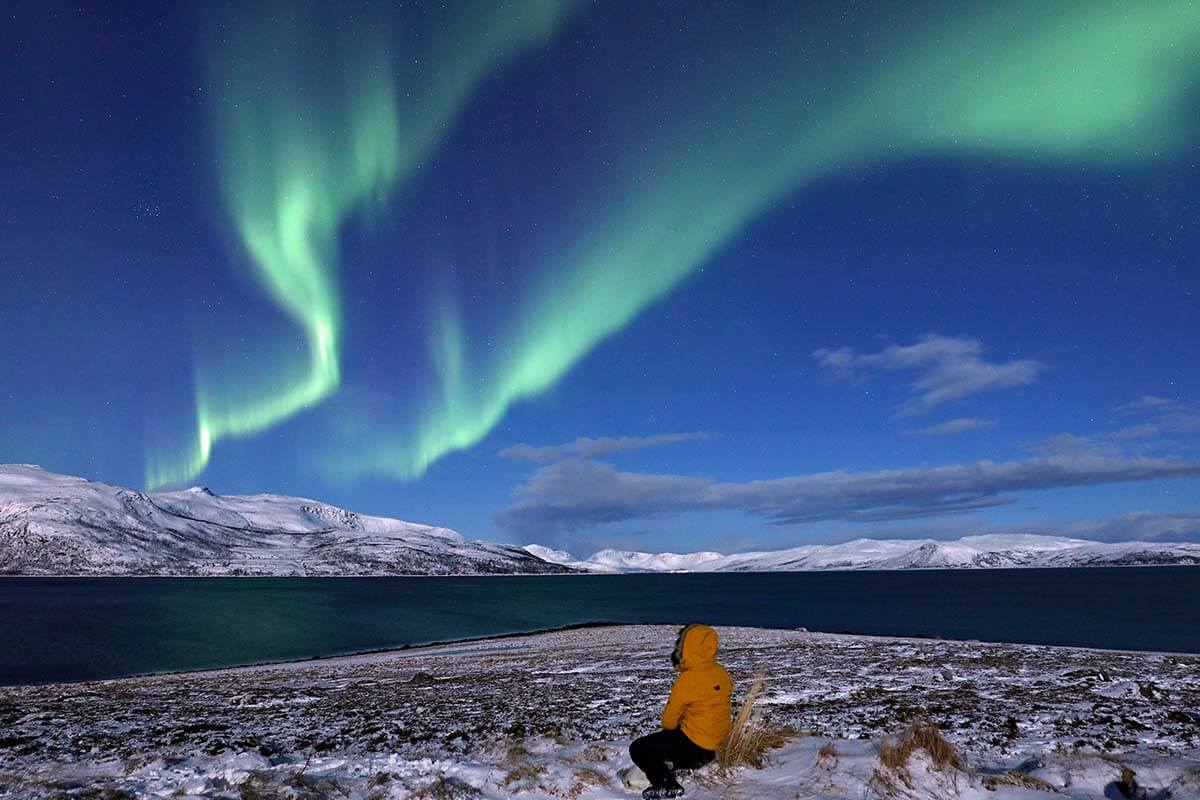
2. Fairbanks, Alaska
Best for: Reliable aurora sightings and wild Alaska adventures.
Fairbanks offers some of the highest probabilities for aurora sightings and is one of the top places to see the northern lights in the world. Located right under the auroral oval, the city gets frequent displays, and with generally clear inland skies and little light pollution, the viewing conditions are excellent. It’s one of the few places where you can realistically expect to see auroras on multiple nights during a short stay.
Furthermore, the aurora season in Fairbanks is long – from late August to mid-April – giving you a longer travel window than most northern lights destinations. In early fall, you can combine aurora hunting with sightseeing and explore Alaska to the fullest.
I visited in September and saw auroras several times, even in the south, while Fairbanks was getting spectacular displays every night. For winter activities, it’s best to plan your trip between late November and March.
Fairbanks is easy to reach with direct flights from several US cities or by Alaska Railroad from Anchorage. There’s even a special Aurora Winter Train in the colder months. The city has all the amenities you need and plenty of other activities: soak in Chena Hot Springs, go dog sledding, visit the Ice Museum, go ice fishing, or explore the nearby wilderness. For darker skies, you can stay outside the city in cabins or lodges where light pollution is minimal.
Auroras are often visible from the outskirts of town, but guided tours increase your chances if conditions are tricky. You can join small-group aurora chases, spend the evening in heated yurts or remote lodges, or combine northern lights viewing with dog sledding, snowmobiling, or even a soak in outdoor hot springs.
For the best experience, plan several nights and, if possible, stay outside town for darker skies (check out this Aurora Villa or stay at Chena Hot Springs Resort). Renting a car is an option, but icy roads and long distances can be challenging in winter; if you’re based in the city, guided tours are often easier and safer.
Additional resources to help you plan your trip to Alaska:
- Alaska Road Trip Itinerary
- Alaska Bucket List
- Alaska in September
- Best Day Trips from Anchorage
- Best Tours from Fairbanks
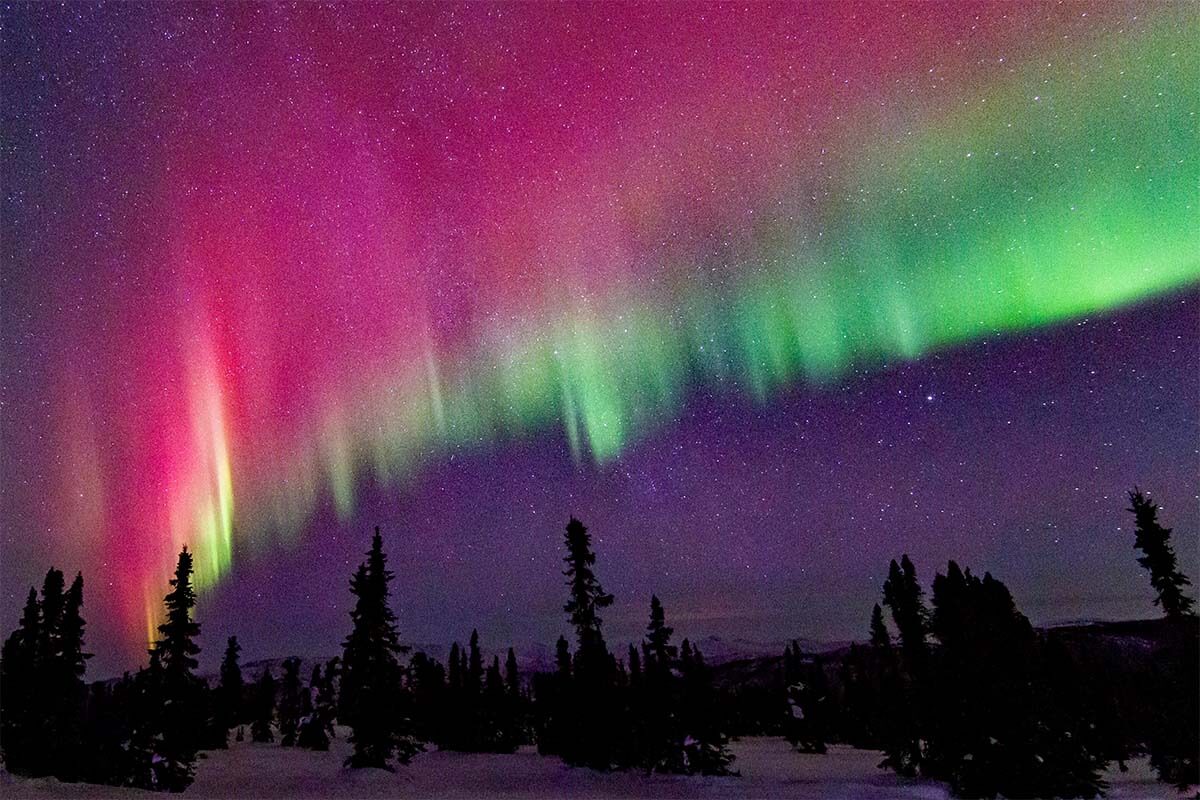
3. Rovaniemi & Finnish Lapland
Best for: Families, winter activities, and luxurious stays.
Finnish Lapland is a classic northern lights destination, and Rovaniemi, right on the Arctic Circle, is its most popular entry point. Aurora borealis is visible here on many nights during the season.
For darker skies and even better chances to see the northern lights, you can head farther north to Saariselkä, Inari, or Levi, but Rovaniemi has the best infrastructure, with plenty to do beyond chasing the lights.
Known as the official hometown of Santa Claus, Rovaniemi is very family-friendly. Plus, it’s easy to reach by plane from many European cities or by overnight train from Helsinki. During the day, you can try reindeer and husky safaris, snowshoeing, snowmobiling, ice fishing, saunas, and of course, visit Santa Claus Village.
Auroras can often be seen right in town, but darker areas just outside offer much better conditions. Tour companies and some lodges also organize campfire evenings in remote locations. And if you stay in a glass igloo resort, you can watch the skies straight from your bed. We stayed at Apukka Resort and saw the green lady dance every night (even from our bed and the jacuzzi).
If the weather doesn’t cooperate, aurora chase tours with guaranteed sightings are the safest bet. Guides may drive several hours, sometimes across the border into Sweden, to find clear skies. If you’re not used to icy winter roads, joining a tour is the easiest and safest way to maximize your chances.
LEARN MORE: Best Spots to See the Northern Lights in Rovaniemi
Additional resources to help you plan your trip to Rovaniemi:
- Rovaniemi Winter Itinerary
- Best Things to Do in Rovaniemi
- Where to Stay in Rovaniemi
- Rovaniemi in March
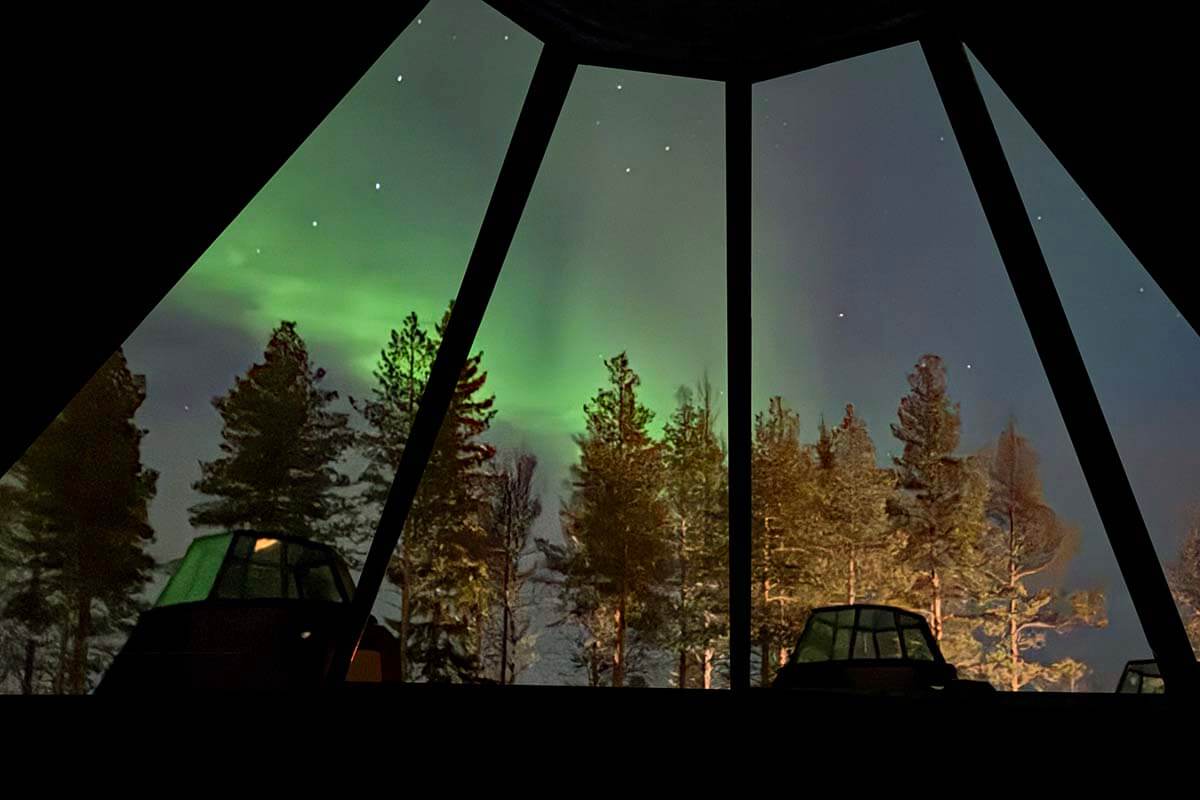
4. Svalbard, Norway
Best for: Extreme Arctic experiences, unique scenery, and auroras during polar night.
If you’re looking for one of the most unique places in the world to see the northern lights, head to Svalbard. Located halfway between mainland Norway and the North Pole, it’s one of the northernmost inhabited places on Earth. Despite the remote Arctic setting, the main town of Longyearbyen is a surprisingly comfortable base, with good hotels, excellent restaurants, and tour options.
What makes Svalbard special is that you can see auroras in the south and even in the middle of the “day.” From mid-November to late January, the archipelago experiences the polar night with 24 hours of darkness. This gives you more chances to catch the lights, but it’s also the coldest time of year, and most outdoor activities are limited.
For a good balance of daylight adventures and long dark nights, February and March are ideal. I visited in February, when there was just enough daylight for dog sledding, ice cave tours, and snowmobiling through the wilderness, while still having great conditions for aurora viewing at night.
Auroras can often be seen right in town, but for the best experience, join a guided excursion. Because of polar bear territory and harsh Arctic conditions, it’s not safe to explore outside town on your own. Tours include snowmobile trips, husky sledding under the polar lights, or camp-style evenings with dinner around the fire.
Svalbard isn’t the easiest or cheapest place to reach, but it’s truly unforgettable. Direct flights connect Longyearbyen with Oslo and Tromsø; just be sure to book accommodation and tours well in advance. And don’t underestimate the cold – this is one of the harshest environments to go aurora hunting!
Good to know: Even though Svalbard is closer to the North Pole than other destinations, it actually sits farther from the auroral oval. This means you’ll need stronger solar activity to see the lights compared to Tromsø or Fairbanks. That said, light pollution is almost nonexistent, so if the skies are clear, your chances are very good, especially if you stay for several nights.
TIP: Thanks to direct flights, you can easily combine two top aurora destinations – Svalbard and Tromsø – on one trip.
LEARN MORE: Best Things to Do in Svalbard in Winter
Additional resources to help you plan your trip to Svalbard:
- Svalbard Travel Guide
- Svalbard in February
- What to Wear in Svalbard in Winter
- Where to Stay in Svalbard
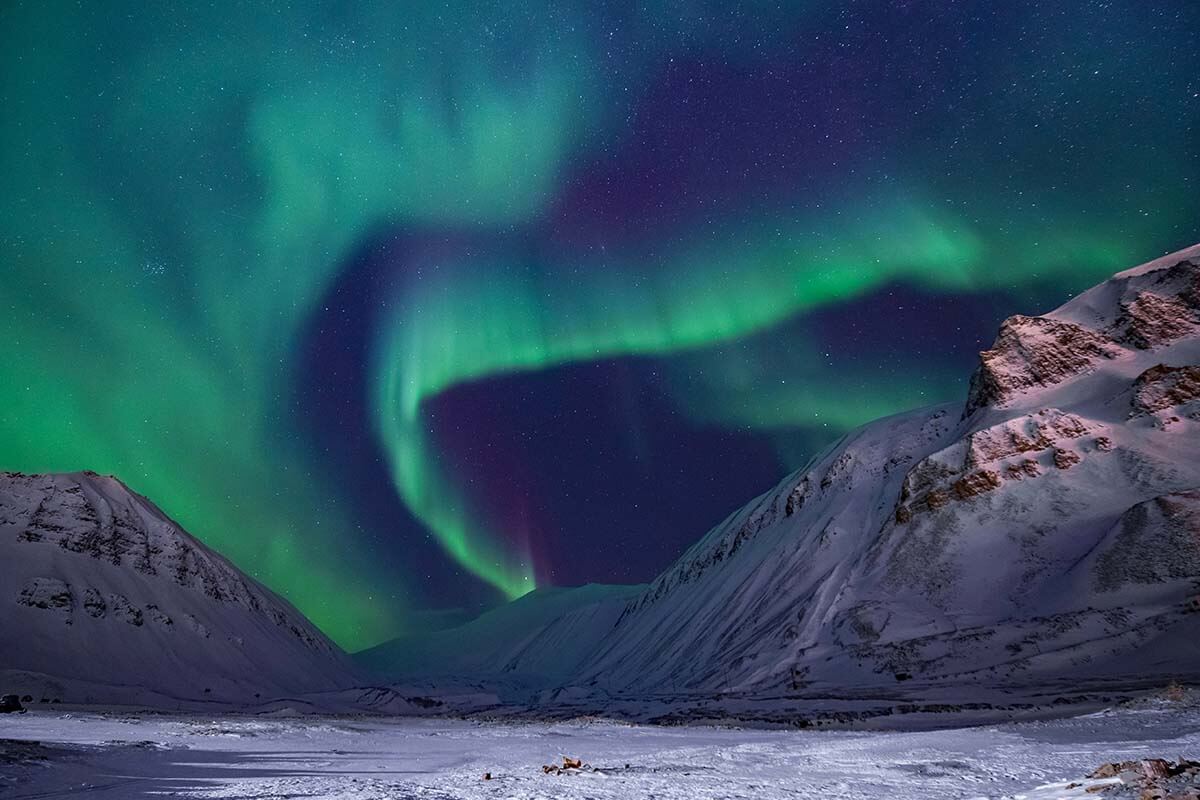
5. Iceland
Best for: Combining auroras with epic landscapes and sightseeing.
Iceland is a great winter destination for those looking to combine aurora hunting with sightseeing, exploring waterfalls, geysers, glaciers, and other natural wonders. Plus, it has countless geothermal hot pools, which make any winter trip so much more enjoyable.
Since most of the island lies under or near the auroral oval, you can see the northern lights all over the country. The big advantage here is that you don’t have to travel too far to find dark skies. The main disadvantage is that it’s often overcast, and it’s not uncommon for the entire island to be covered in clouds for days in a row.
The weather in Iceland is highly unpredictable, which is why – despite its prime location under the aurora oval – your chances of seeing auroras here aren’t as high as in the above-mentioned destinations. That said, if you stay for 5-6 days, you should be able to see auroras at least once. And if you’re lucky, you might see them every single night.
For the best experience, plan a road trip, especially if visiting in the early fall when driving conditions are generally good.
If you’re visiting in mid-winter and don’t feel comfortable driving in icy, stormy conditions, book a multi-day guided tour. Staying in remote countryside hotels or guesthouses gives you a much better chance of seeing auroras right outside your room. I’ve seen amazing aurora displays all over Iceland on countless occasions, without ever needing to go on a chase.
TIP: On a shorter visit, Reykjavik is a great base for winter tours, including aurora tours by bus, jeep, or even boat – many of which offer a free second try if you don’t see the lights the first time.
LEARN MORE: Northern Lights in Iceland
Additional resources to help you plan your winter trip to Iceland:
- Tips for Visiting Iceland in Winter
- Iceland Winter Itinerary
- Best Tours from Reykjavik in Winter
- Driving in Iceland in Winter
- Best Winter Experiences in Iceland
- What to Pack for Iceland in Winter
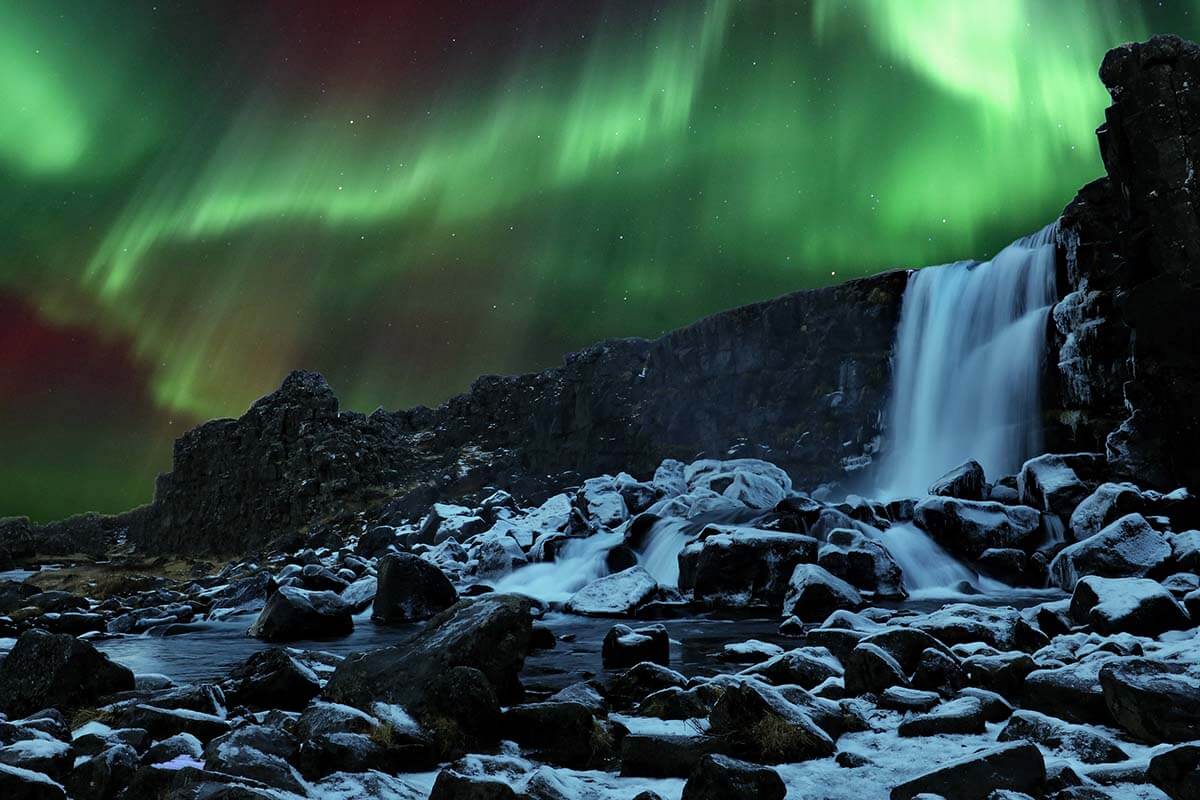
So, this is our guide to some of the absolute best aurora-viewing destinations around the world. Fairbanks and Tromsø give you the highest chances of seeing the northern lights. Rovaniemi offers a great balance of family-friendly activities and aurora opportunities, while Svalbard delivers a truly unique Arctic experience. Iceland has epic scenery and is worth a trip even if the lights don’t appear.
No matter where you go, plan to spend several nights, keep an eye on the aurora forecast every night, and actually make the effort. I can’t tell you how many times I’ve seen people miss incredible aurora shows simply because they didn’t want to bundle up and step outside after bedtime…
PRO TIP: If you expect to see auroras from the comfort of your bed, splurge and book several nights in a glass igloo in Lapland. Check out our Rovaniemi hotel guide for the best recommendations and book well ahead – the nicest accommodations often sell out months in advance.
TIP: Did you find this guide helpful? Bookmark this post for later, share it with your friends, and save it to Pinterest to inspire your next trip.
